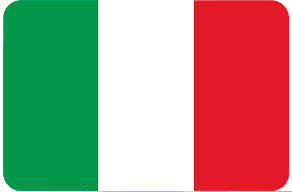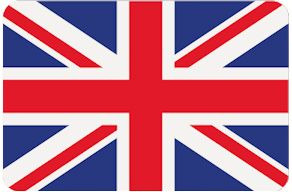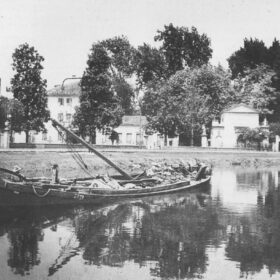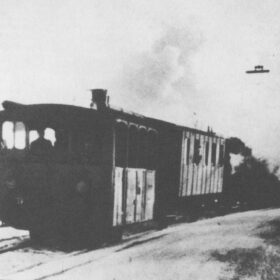
Lo storico Tito Livio parla di una flotta greca comandata dallo spartano Cleonimo che intorno al 302 a.C. si sarebbe spinta fino ai lidi della laguna veneta. Il condottiero si sarebbe spinto ancor più in là risalendo il corso del fiume Medoacus Major, l’attuale Brenta, saccheggiando alcuni villaggi padovani. Della località parla anche Marziale; Vitruvio e Strabone informano sulla agiatezza economica goduta dalle popolazioni dell’estuario durante la dominazione romana.
Con la decadenza dell’Impero Romano iniziarono le invasioni barbariche che sconvolsero le popolazioni: si ricordano le azioni di Pipino, di Ezzelino, degli Ungari che furono le più devastanti. Alle razzie barbariche si aggiunsero le disastrose piene del Brenta, che compromisero ancor di più le condizioni di vita, e alle quali si cercò di far fronte con tagli e scavi di nuovi corsi d’acqua.
Intorno al 1142 i Padovani operarono un taglio sul fianco sinistro del Brenta provocando una diversione delle acque verso il territorio di Sant’Ilario, sede dell’importante abbazia benedettina. Questa era sorta agli inizi dell’800 per opera appunto dei benedettini, su un terreno lasciato in donazione dai dogi Angelo e Giustiniano Partecipazio, divenendo in breve tempo un centro di attività di bonifica dei territori paludosi, di incremento agricolo, di caccia e di pesca.Ma il monastero era destinato a decadere a causa dei continui scontri tra Veneziani e Padovani che se ne contendevano il possesso poiché veniva a trovarsi in una posizione di confine.
Nel 1250 venne preso da Ezzelino, nel 1375 dai Carraresi. Dopo la guerra di Genova (1379) fu definitivamente abbandonato e invaso dalle acque. I contrasti tra Padova e Venezia terminarono definitivamente verso la metà del ‘500 dopo che Venezia riuscì ad avere la meglio e ad eleggere un provveditore per l’amministrazione di questa parte di terraferma; la sede della Provveditoria si trovava nell’attuale Piazza Mercato-Gambarare. Dalla metà del XVI secolo si iniziò la costruzione di ville, barchesse e oratori per opera di architetti famosi quali Palladio e Longhena, che seppero realizzare quelle case di villeggiatura decantate come oasi di serenità nell’amena campagna lungo il fiume.
Tutto questo termina con la decadenza di Venezia. L’occupazione straniera, francese e austriaca, segna un inesorabile declino economico e culturale. E tuttavia si ha proprio in questo periodo l’avvio di una attività industriale, ancora elementare, caratterizzata da impianti per la produzione di candele e sapone, per la marinatura delle anguille, da fabbriche di laterizi e da numerose lavanderie.Nel 1866 Mira è annessa all’Italia, e nell’anno seguente i tre Comuni di Mira, Oriago, Gambarare, si fondono in uno solo, che assume il nome di Mira: da qui lo Stemma Comunale con le tre corone, simbolo dei tre precedenti Comuni.

The historian Tito Livio speaks of a Greek fleet commanded by the Spartan Cleonimo who around 302 BC. it would have gone as far as the shores of the Venetian lagoon. The leader would have gone even further by going up the river Medoacus Major, the current Brenta, sacking some Paduan villages. Martial also speaks of the locality; Vitruvius and Strabo report on the economic wealth enjoyed by the people of the estuary during the Roman domination.
With the decline of the Roman Empire began the barbarian invasions that shocked the populations: remember the actions of Pipino, Ezzelino, the Hungarians which were the most devastating. The disastrous floods of the Brenta were added to the barbarian raids, which compromised living conditions even more, and which they tried to cope with with cuts and excavations of new waterways.
Around 1142 the Paduans made a cut on the left flank of the Brenta causing a diversion of the waters towards the territory of Sant’Ilario, seat of the important Benedictine abbey. This was built at the beginning of the 19th century by the Benedictines, on a land left as a donation by the Doges Angelo and Giustiniano Partecipazio, quickly becoming a center of reclamation of marshy territories, of agricultural increase, of hunting and fishing. But the monastery was destined to decay due to the continuous clashes between the Venetians and Padovans who competed for possession as it found itself in a border position.
In 1250 it was taken by Ezzelino, in 1375 by the Carraresi. After the war in Genoa (1379) it was definitively abandoned and invaded by the waters. The contrasts between Padua and Venice definitively ended in the mid 1500s after Venice managed to prevail and elect a supervisor for the administration of this part of the mainland; the headquarters of the Provveditoria was located in the current Piazza Mercato-Gambarare. From the mid-sixteenth century, the construction of villas, barchesse and oratories began by famous architects such as Palladio and Longhena, who were able to build those holiday homes praised as an oasis of serenity in the pleasant countryside along the river.
All this ends with the decline of Venice. The foreign occupation, French and Austrian, marks an inexorable economic and cultural decline. And yet it was precisely in this period that an industrial activity began, still elementary, characterized by plants for the production of candles and soap, for the marinating of eels, brick factories and numerous laundries. In 1866 Mira was annexed to Italy, and in the following year the three Municipalities of Mira, Oriago, Gambarare, merge into one, which takes the name of Mira: hence the Municipal Coat of Arms with the three crowns, symbol of the three previous Municipalities.


